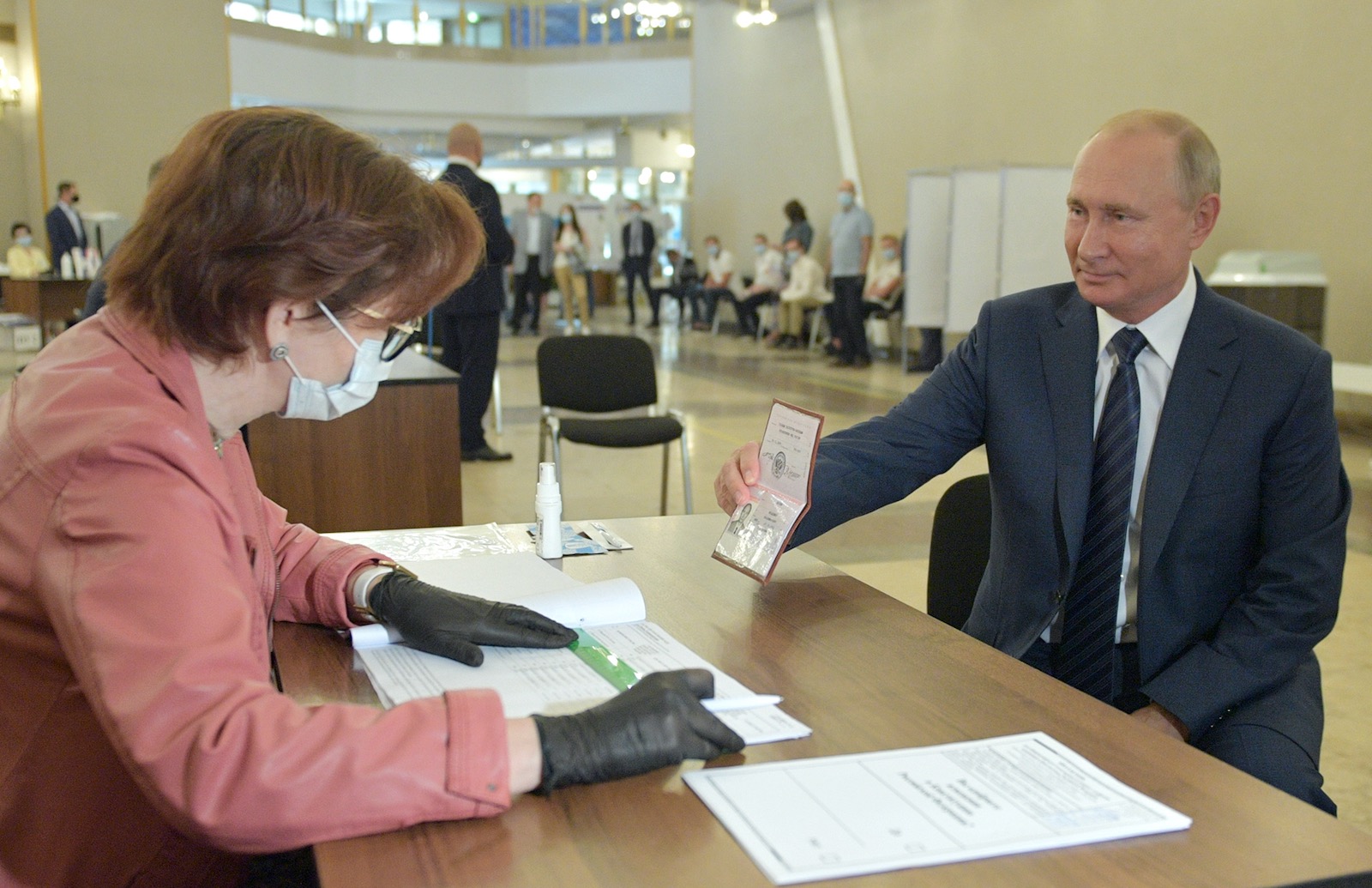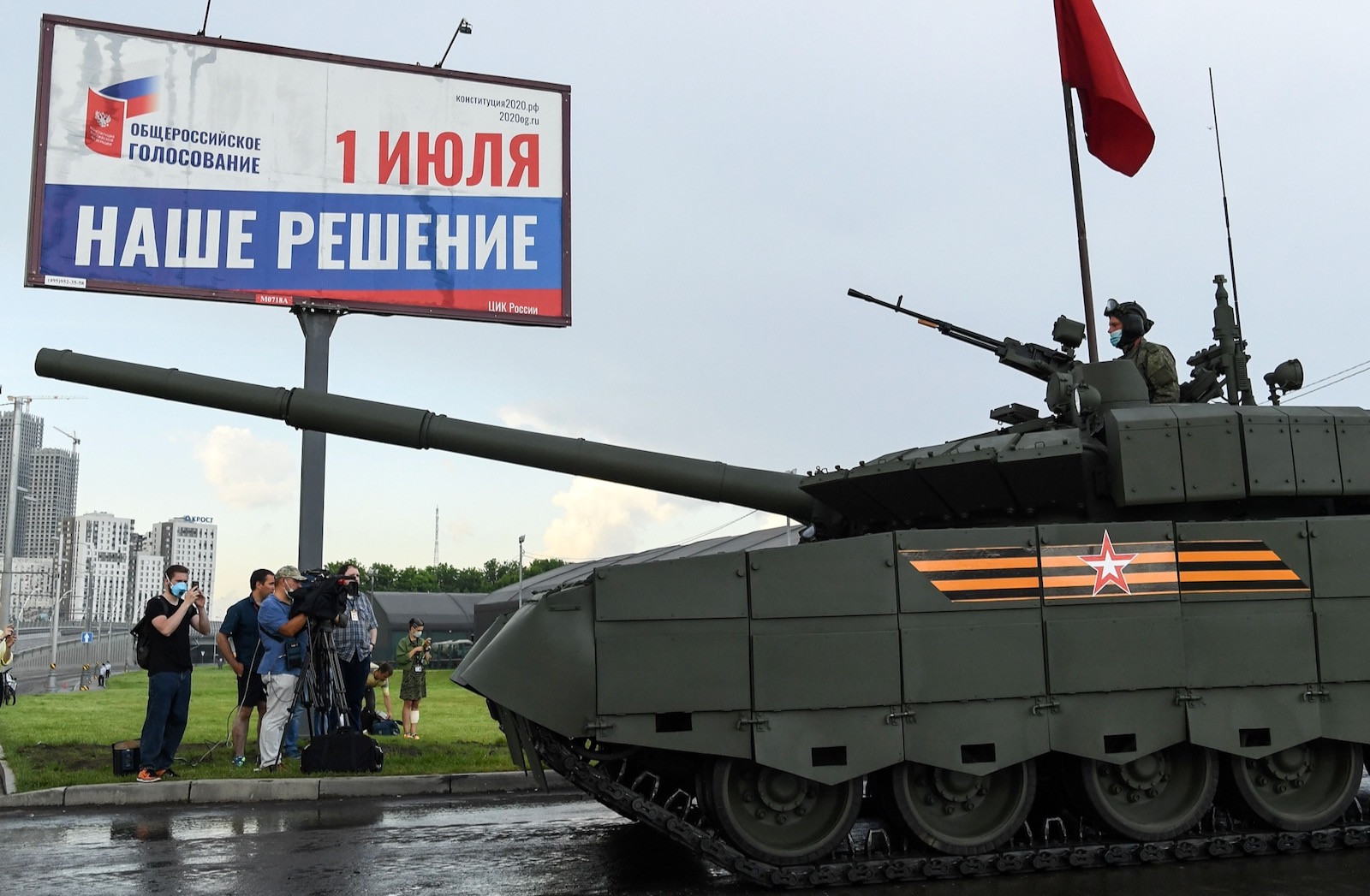On July 1, after “recovering,” by decree, from the coronavirus pandemic, Russia held a vote on a package of constitutional amendments. Introduced by Vladimir Putin back in January and expanded by the State Duma over the following months, the 206 changes are touted as protecting Russia’s sovereignty, defending Russian history, and boosting Russians’ economic well-being. The amendments also nullify the previous presidential terms of Vladimir Putin, allowing him to run again for the presidency when his current, fourth term expires—in effect, extending his twenty-year grip on power indefinitely. “Russia’s strength,” explained the chairman of the Duma when talking about amendments, “is not oil and gas, but Vladimir Putin.”
Though results weren’t formally in until July 2, the triumphal outcome of the referendum was never in doubt: Russian bookstores were already selling copies of “the new Constitution,” as if it were a fait accompli from the middle of June. Even as early as March, Ella Pamfilova, the head of the Central Election Commission, declared amendments as “already legitimate” and lauded President Putin’s effort to solicit “non-required” popular assent—a concept Pamfilova apparently disdained, judging by her smirk as she uttered the phrase.
When asked about the legitimacy of “packet” (or wholesale) voting, as opposed to voting on each individual amendment, Pamfilova compared Russia’s constitutional referendum with a prix fixe restaurant meal. If you didn’t like the beet salad but did like the borscht or the cutlets, she offered, you’d need to decide whether to turn down the whole dinner or simply skip the salad and enjoy the borscht and the cutlets. In other words, there would be no à la carte choice: if you don’t like the amendment that makes veiled threats against anyone considered to be undermining Russia’s “territorial integrity,” then you don’t get to vote on the measure guaranteeing indexed pensions either. It’s all or nothing.
Pamfilova’s cynicism is entirely explicable: in Russia, the constitution has rarely been a covenant of good governance between the state and the people. Rather, it is a tool to enshrine imposed order and provide a legal pretext for cracking down on dissent. Even a cursory look at Russia’s history suggests that if “they”—which is the way Russians routinely refer to the authorities—are reaching for the constitution, bad things are afoot.
The first Russian constitution was a reaction of Tsar Nicholas II to the bloody 1905 revolution that shook the Romanov autocracy to the core, throwing its very survival into doubt. The Constitution of 1906 established the State Duma, or parliament, and granted civil liberties, including freedom of speech, press, and assembly. Those promises were quickly undone by a wave of repressions that filled the prisons and sent thousands to the scaffold, often without trial. As for the Duma, Nicholas could dissolve it at will, which he did twice, weeding out opposition groups and restoring himself as Russia’s absolute ruler until the overthrow of monarchy in March of 1917.
None of the subsequent, Soviet-era constitutions amounted to much more than propaganda tools that portrayed the totalitarian, one-party state they served as the “state of the people.” All presided over gross civil rights abuses of the very people whose interests they claimed to protect.
Take Lenin’s “revolutionary” constitution that proclaimed “the dictatorship of the proletariat” as Russia’s new political order. Enacted amid the raging civil war, it described the Bolshevik seizure of power as an expression of popular will; it thus legitimized the nationalization of private property and billed the new state’s authority as “not limited by any laws.” Six days later, on July 16, 1918, the deposed Tsar Nicholas was murdered, along with his family, inaugurating a wave of mass repression known as the Red Terror.
Or take Stalin’s constitution of 1936, which declared successful construction of the socialist state. Having promised full civil rights to all, including remnants of the “eliminated” exploiter classes, this constitution in fact coincided with the beginning of the Great Terror, which claimed millions of lives, among them countless numbers of workers and peasants whose interests the constitution ostensibly advanced. But Stalin was nothing if not thorough: the legal grounds for that murderous campaign—the designation “enemies of the people”—was inscribed in Article 132 of that document.
Not as deadly in per-capita death sentences, Brezhnev’s constitutional project was nevertheless another exercise in empty rhetoric. Proclaiming the arrival of the advanced phase of socialism, marked by “broader democracy” and “peaceful cooperation,” the Constitution of 1977, with which I would grow up, turned out to be a prelude to the 1979 Soviet invasion of Afghanistan and further suppression of dissidents. Under that banner of “advanced socialism,” Brezhnev’s regime swelled the ranks of “politicals” in prisons and psychiatric hospitals and of “refuseniks,” as citizens who were denied permission to emigrate were known (the family of my future husband fell into that category). For the rest, “broader democracy” came with shortages of everything and compulsory voting in “free elections” that had just one name on the ballot. “In USSR,” as I copied dutifully into my school social science notebook, “all power belongs to the people.”
Advertisement
The 1993 Yeltsin Constitution, written atop the ruins of totalitarian USSR, formally did away with the Soviet system of government and rearranged Russia as a super-presidential republic. It abandoned censorship, declared freedom of conscience and of movement, and reinstated citizens’ right to private property. In a serious departure from the previous constitutional projects, Yeltsin’s actually upheld the civil rights it promised. The right to private property may have translated into immense riches for some and nothing but privatized tiny Soviet-era apartments for the rest, but the last decade of the last century may have been the freest Russians ever experienced. Alas, the constitution itself was adopted only after President Yeltsin had ordered tanks to shell the building of his recalcitrant parliament, arrested members of the opposition, and then disbanded the parliament altogether, seriously undermining the democratic intent of the constitution.
It was that 1993 constitution that Vladimir Putin used as the basis of building his “power vertical,” the centralized, top-down model of government by which loyalists are appointed to important judicial, legislative, and executive positions. In 2008, when it was time for Putin to depart because of the then-existing constitution’s term limits, he simply switched seats with his prime minister, Dmitry Medvedev, who then pushed through constitutional amendments in the State Duma that modified the duration and limit of presidential terms, allowing Putin eventually to run for presidency again. The scheme caused widespread popular protests—and led to a crackdown on independent media and opposition. In 2018, four years after Russia annexed Crimea “to protect interests of ethnic Russians,” Putin was elected for another, now six-year presidential term by one of those same “overwhelming” majorities with which Russians who can recall the Soviet era are so familiar.
Now, the past two decades of Putin’s rule—marked by the reinstatement of censorship, the systematic persecution of political opponents, and “hybrid wars” against “enemies” across ideological spectrum—has been retroactively legitimized by the refashioned constitution. The rewrite not only offers Putin a path to lifetime rule by “nullifying” his previous terms, but also grants him personal immunity when, or if, he ever quits the political arena. The new constitution neutralizes all decisions of international courts, the opposition’s last resort in contesting domestic sentences, by giving precedence to Russian law over international treaties and obligations, and offers additional avenues to criminalize deficiencies of patriotism as defined by the state, with offenses such as “diminishing the significance of the people’s heroism in defending the Fatherland.”
As for freedom of conscience, marriage is constitutionally defined as the union between a man and a woman, while Russians are described en masse as a “state-forming people,” loyal to the “memory of ancestors,” who endowed them with “faith in God” and unspecified “ideals.” Just as was the case with the Stalin’s constitution, the rearing of children is now a priority of the state, which aims to see them raised in the spirit of “patriotism” and “civic engagement.”
All that is wrapped into a hodgepodge of “social” amendments, most of which already exist in various decrees and federal laws. These include mandates for a minimum wage (about $170 dollars a month); annual adjustments of the state pension; accessible health care; and stable economic growth, achieved through a partnership of “solidarity” between the people and the state. Those amendments looked great in the advertisements that flooded Russia’s otherwise barren media space in a bid to boost the referendum turnout and distract attention from Putin’s proposed lifetime rule and the new punitive measures.
Russia being a strongman’s domain, Vladimir Putin could have achieved his goals, as he always has, simply by pulling on the various levers of his power vertical. There is no organized resistance to the current order; the country is stable and the military is loyal. Why engage in this lengthy political spectacle of rewriting the Constitution?
The answer may lie in Putin’s ambition: only a truly great leader, by his reckoning, can succeed in enshrining his personal whims as the “law of the land.” As a president who has built his legacy around restoring Russia’s strength, Putin sees himself as the “defender of Fatherland,” a nebulous category in his constitution that could be applied to anyone from World War II veterans, whose memory he has usurped, to the “defenders of socialism” from the state security organs of the Stalin’s era, also hailed as heroes. Propped up by the God he has now plugged into the Constitution, Putin wants to reign supreme over his vast domain, a father to a “nation of victors,” a tsar in all but the name.
Advertisement
Yet, if history offers any lessons, this attempt at greatness will last no longer than the false covenants and official statues every autocracy erects, for they fail in their fundamental goal: improving the lives of the people. The legacy of Stalin and Lenin is not a socialist empire but the graves of millions, murdered and tortured in its prisons. The legacy of Brezhnev is not “advanced socialism” but Chernobyl.
Putin is more likely to be remembered not as the “Father” of “Great Russia,” but as the ex-KGB apparatchik who squandered the promise of perestroika for a hollow, “post-truth” regime held together by cynicism and corruption. Just like his predecessors, he succeeded in pushing through his “beet salad” constitution, but one day Russians may decide they want something else on the menu.




